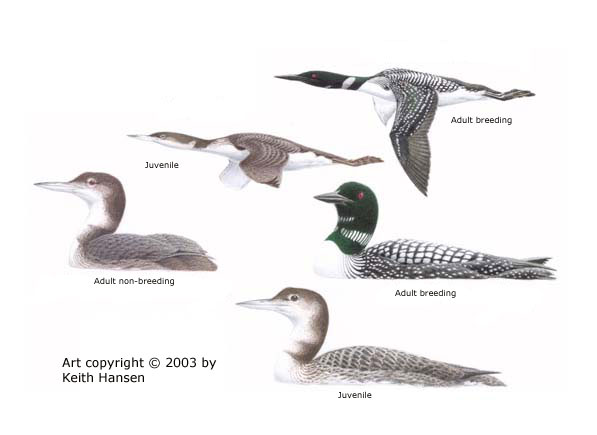Featured Species: Common Loon
Common Loon (Gavia
immer)
(Sw immer, ember, blackened ashes, apparently referring to dark plumage.) Description.
Description.
L: 29-32" W: 13-14"
Body large, long, and flat. When active, rides low in water; floats higher when resting or preening. Head blocky, rectangular, and set on thick neck. Shows a small bump on forehead, unlike other Sierra loons. Bill straight and dagger- like, with slight angle midway to tip on lower mandible. Runs on water with loud slapping sounds when taking flight. Flies with quick, powerful shallow strokes on slender pointed wings. Flaps continuously; movement appears to be concentrated in wing tips.
Breeding Adult: Seldom occurs in Sierra in this plumage. Head and neck deep dark green, but appears black under most lighting. Shows unique striped, white collar and chin stripe. Back and flanks black with rows of large, white squares or speckles throughout.
Winter Adult: Shows white crescent around eye. Back dark and generally unmarked. Sides of neck marked by dark band and pale notch giving it a somewhat ragged appearance, unlike Pacific Loon. Adults moulting into breeding plumage (March-May) typically appear much like nonbreeding birds but with traces of breeding plumage emerging throughout the body, especially on the back and neck (not illustrated).
Juvenile: Best told from nonbreeding adult by light barring on back feathers created by pale feather edgings. Overall browner, paler, and more muted than nonbreeding adult.
Voice: Gives a loud, long, drawn-out eerie yodel on breeding grounds; silent outside breeding range.
Similar Species:
Winter adult's neck marked by a dark band and pale notch, giving a ragged
appearance, unlike the smaller Pacific and Red-throated Loons; differs from
cormorants by larger size, body mass, thick neck and bill, plumage coloration,
and flight shape; distinguished from Common Merganser by bill shape, smooth
head, larger size, and overall coloration.
Natural History. Among the world's most accomplished diving birds, Common Loons make foot-propelled dives that may exceed depths of 200 feet. Small fish are their preferred prey but they also consume crustaceans, aquatic insects and plants, including algae. Although capable of extremely deep dives, Common Loons usually forage near the bottom in relatively shallow, nearshore waters. While swimming along the water's surface, they may partially submerge their bills and cock their heads to peer for fish underwater. Once prey items are spotted, they dive forward with energetic leaps and are capable of long underwater pursuits.
Distribution and Habitat. Nonbreeding visitors from northern breeding grounds, most Common Loons in California remain in coastal waters. Each year, however, individuals regularly appear on large lakes and reservoirs in California's interior. West slope: Common Loons are uncommon but regular visitors to large reservoirs such as Lake Almanor, Folsom Lake, Millerton Lake, and Lake Isabella; on rare occasions, nonbreeding individuals remain through summer. In late summer and fall, migrating Common Loons occasionally appear at large subalpine lakes, such as at Tenaya Lake in Yosemite National Park. East slope: Common Loons are fairly common in fall, winter, and spring at large, water bodies such as Lake Tahoe, Donner Lake, Topaz Lake, Boca Reservoir, Bridgeport Lake, and Lake Crowley, but they usually abandon these lakes if substantial areas of open water freeze in winter. In April, the largest concentration of migrating Common Loons west of the Mississippi River gathers at Walker Lake, northeast of Mono Lake in the Great Basin, with "spillover" birds possibly accounting for many eastside records.
Conservation Status. While late nineteenth century accounts documented Common Loons nesting just north of the Sierra at Eagle Lake, and a few other large lakes above 5,000 feet east of Mt. Lassen, they were probably extirpated as a breeding species in California by the early 1900s. The following account by C. H. Townsend is one of the only descriptions of Common Loons nesting from the Lassen region. On July 10, 1884, he wrote: "...I waded out to a narrow sand bar...upon which a [Common] Loon had been sitting, and found her nest or rather egg...which was lying on the sand." The cause of the Common Loon's disappearance as a breeding species from California is unknown, but it may have been related to human disturbance of their nest sites. Studies in other parts of North America have shown that the mere presence of boats, even a single canoe passing too close, can disturb nesting adults and cause them to abandon their nests and young.
Identification Tips (from Patuxent Wildlife Research Center)
A Look at the Common Loon (from North American Loon Fund)
Voices of the Loon (from GMN Photography)
Our Founder Questions? Go to About Our New Site |
Masthead
Photo from: |